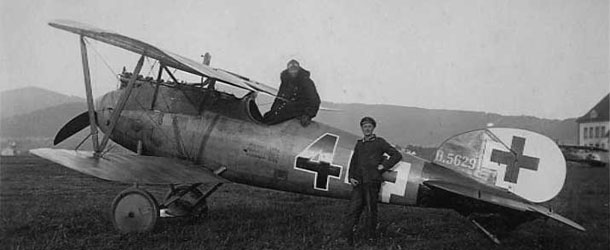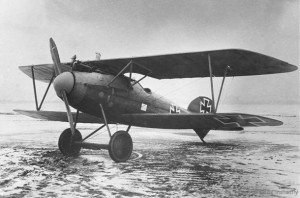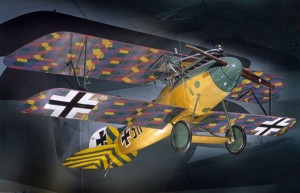The fighter Albatros D.Va is the final development of the D.I family. Used by Luftstreitkräfte (Imperial German Air Service) during World War I, it is one of the aircrafts included in the next WW1 Wings of Glory Airplane Packs. It was built in large numbers and served for many months on the Western Front. Despite its limited performance and structural shortcomings, the Albatros D.Va was used in combat against all type of enemy airplanes. Aces like Ernst Udet, Bruno Loerzer, Gerhard Bassenge, Paul Baumer, Carl Menckhoff, Hans Klein, Otto Konnecke and Fritz Rumey flied with it.
The D.Va was the last Albatros fighter to enter in operational service. In 1916, the single-seat Albatros D.I had brought air superiority to the German Empire, with an outstanding rate-of-climb, aerodynamical design and a lethal pairing of synchronized machine guns. But it didn’t last long, and the aircraft was outclassed by the latest fighters of the Triple Entente. The D.II was a slightly improved model, unveiled a short time later in the same year, and it was followed in late 1916 by the D.III, which used the same semi-monocoque, plywood-skinned fuselage of the previous models, but adopted a sesquiplane wing arrangement.
When the D.III entered in service, it was immediately acclaimed by German aircrews for its maneuverability and rate of climb, but soon it began experiencing a lower wing defect that led to wing failure in steep dive. After some attempts to rectify this problem, Luftstreitkräfte required an improved D.III, leading to the development of the D.V.
The Albatros D.V retained the wing and tail design of the Albatros D.III and used the same 127 kW (170 hp) Mercedes D.IIIa engine. The major new innovation was the D.V's elliptical cross-section fuselage, compared to the flat-sided fuselage of the earlier models, 32 kg (70 lb) lighter than that of the D.III. The new version had a larger tail fin and the top wing was lowered and brought closer to fuselage, improving the pilot's visibility. The D.V was delivered to the fighter squadrons in May 1917, and soon there was a series of fatal crashes caused by wing failure.
Besides the structural problems, the D.V offered very little improvement in performance, and this caused considerable dismay among frontline pilots, many of whom preferred the older D.III. One of the most critical was Manfred von Richthofen, the "red Baron". In a July 1917 letter, he described the D.V as "so obsolete and so ridiculously inferior to the English that one can't do anything with this aircraft."
The engineers decided to move the aileron control wire back to the lower wing and strengthen the attach point of the V-shaped strut that connected the lower spar to the fuselage. For additional safety, they also added an additional strut to the lower wing spar. The modifications made the aircraft 23 kg (50 lb) heavier than the D.III, and a more powerful Mercedes D.IIIa engine was installed. With these changes. the airplane received the classification of Albatros D.Va.
Despite the modifications, the aircrafts’ structural issues were never completely solved and the D.Va’s performances and maneuverability were still not on a par with contemporary French and British fighters. Even so, there were no viable alternatives to it, and the German Empire ordered to send the D.Va to his squadrons. The first units were delivered in October 1917. More than 1,600 units were built until the production ceased in early 1918. By May 1918, 131 D.V and 928 D.Va aircrafts were in service on the Western Front. This number declined as the Albatros was replaced by Fokker D.VIIs and other types during the final months of the war, but the D.Va remained in use until the end of the war.
Approximately 4,800 Albatros fighters of all types were built during World War I. Many of the highest-scoring German aces achieved the majority of their victories while flying Albatros aircrafts. Despite the large production and pervasive presence of these fighters during World War I, only two have survived, and both are D.Va models. One is at the Australian War Memorial Museum in Canberra, Australia. The other is in the collection of the National Air and Space Museum, in Washington, USA.
The three versions of the Albatros D.Va featured in the Airplane Packs are the fighters piloted by Ernst Udet, Hans Joachim von Hippel and Josef Carl Peter Jacobs, which will be presented in the next article.
Information sources: The Aerodrome, Wikipedia, Military Factory, WW1 Aviation, The Aviation History Online Museum, Smithsonian Institution's National Air and Space Museum.











